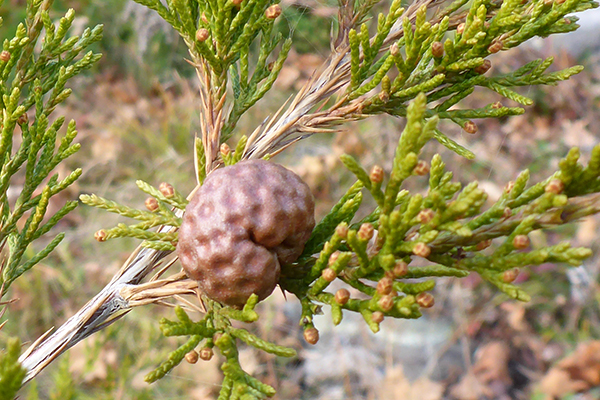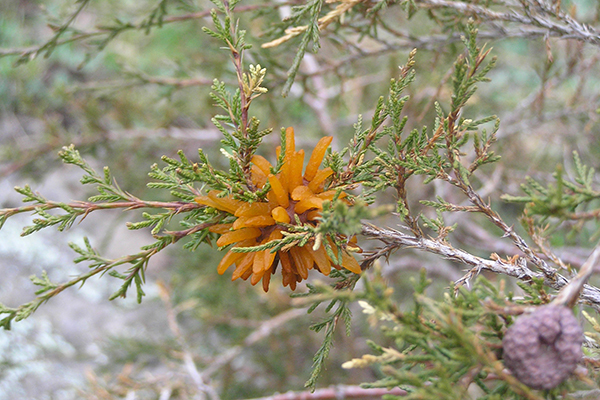This spring, you might be surprised to look at a juniper or cedar on your property and see bold, orange, spiky blobs on its branches. They’re not cones or fruits on the cedar. They’re actually one stage in the life of a complicated fungal disease: cedar apple rust.
This spring, you might be surprised to look at a juniper or cedar on your property and see bold, orange, spiky blobs on its branches. They’re not cones or fruits on the cedar. They’re actually one stage in the life of a complicated fungal disease: cedar apple rust.
Cedar apple rust is one of a group of fungi that need two different kinds of plant hosts to survive. Appropriately, cedar apple rust infects cedars (as well as a few other junipers) and apples (and crabapples).

Eastern red cedar is a host for cedar apple rust. Photo credit: Elizabeth Bush, Virginia Polytechnic Institute and State University, Bugwood.org
Here’s how this complex life cycle works. In spring, the fungus growing on a cedar releases spores intended for the apple. If the spores land on an apple tree’s developing leaves or flower tissues, the fungus will invade and parasitize it through the growing season. By late summer, infested apple leaves produce and release spores intended for cedar. If these spores land on cedar leaves and branches, they can infest it and restart the host cycle next spring.
Weird!
On cedar trees, the fungal infection can be seen year-round as a brown mass called a gall, which can develop a golf ball-like appearance when it gets larger. These can get to be more than an inch across.

For most of the year, cedar apple rust exists as a brown gall on cedar branches. Larger galls like this one develop circular depressions, giving them a golf ball-like appearance.
Even though the galls can be big, they’re hard to notice against the background tree color. But that changes in the spring. The first warm, heavy spring rains trigger the extension of orange gelatinous horns from the gall. Like a mushroom’s toadstool, the horns’ purpose is to disperse spores to infect apple trees.

The first warm rains of spring cause the gall to produce orange gelatinous “horns” that release spores. These spores can travel miles on the wind to infect apple trees.
Cedar apple rust rarely harms cedars, though it can occasionally cause the twig beyond the gall to die and fall off. On apple trees, though, it can infect the fruit, reducing production.
That loss of production means professional apple growers have a very negative opinion of cedar apple rust. For them it can lead to big economic losses, so they use both mechanical and chemical methods to control it. They’ll commonly cut and remove nearby cedar trees to interrupt the host cycle, and they’ll also remove leaves and other pruned materials that could be harboring the fungus or spores. Some farmers also apply a chemical fungicide to emerging apple leaves in the spring to beat back the rust.
Unless you own an orchard, though, you don’t need to do anything if you see this rust on your trees. For me, it’s just an interesting oddity on the cedar in my backyard.





